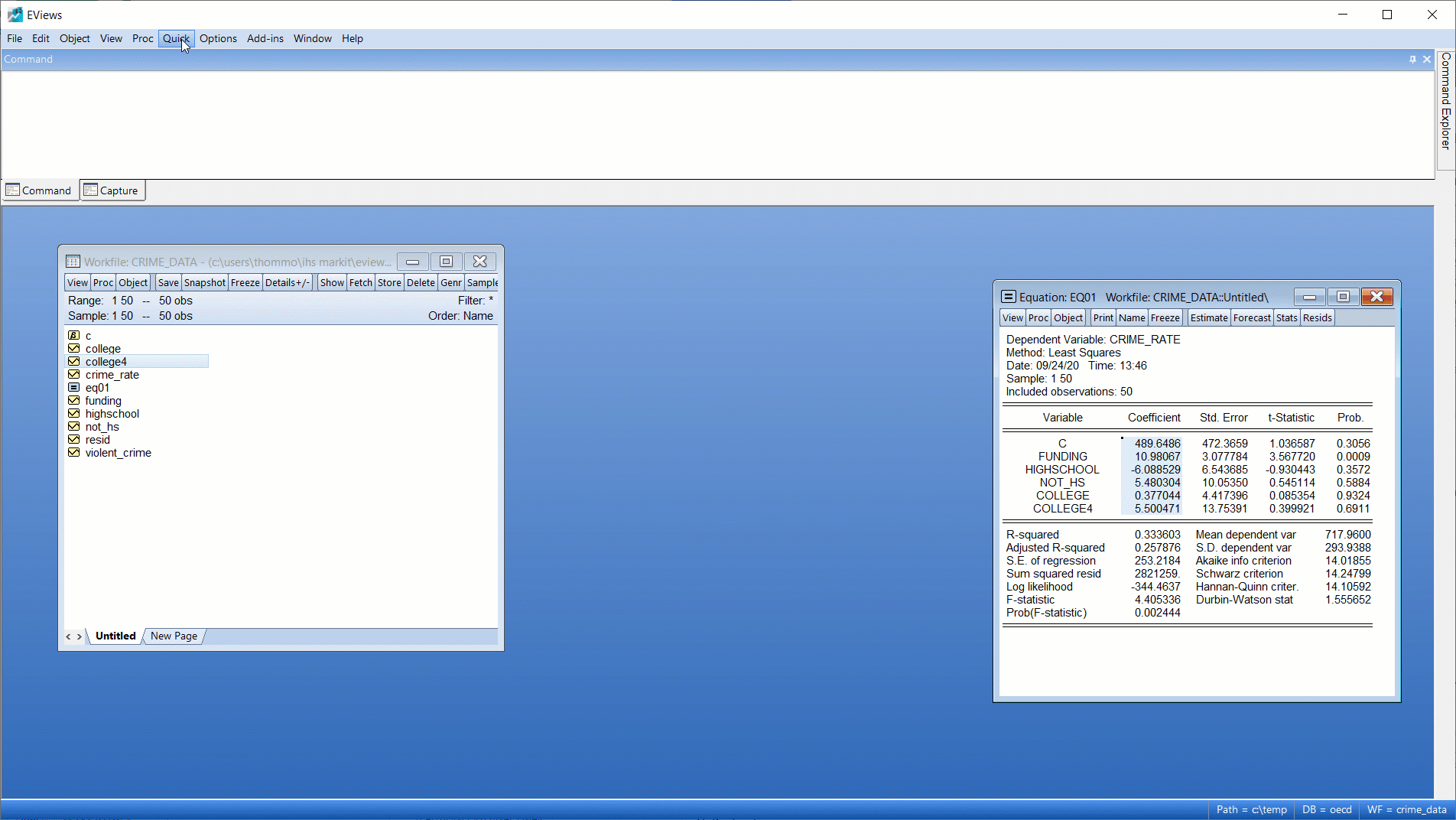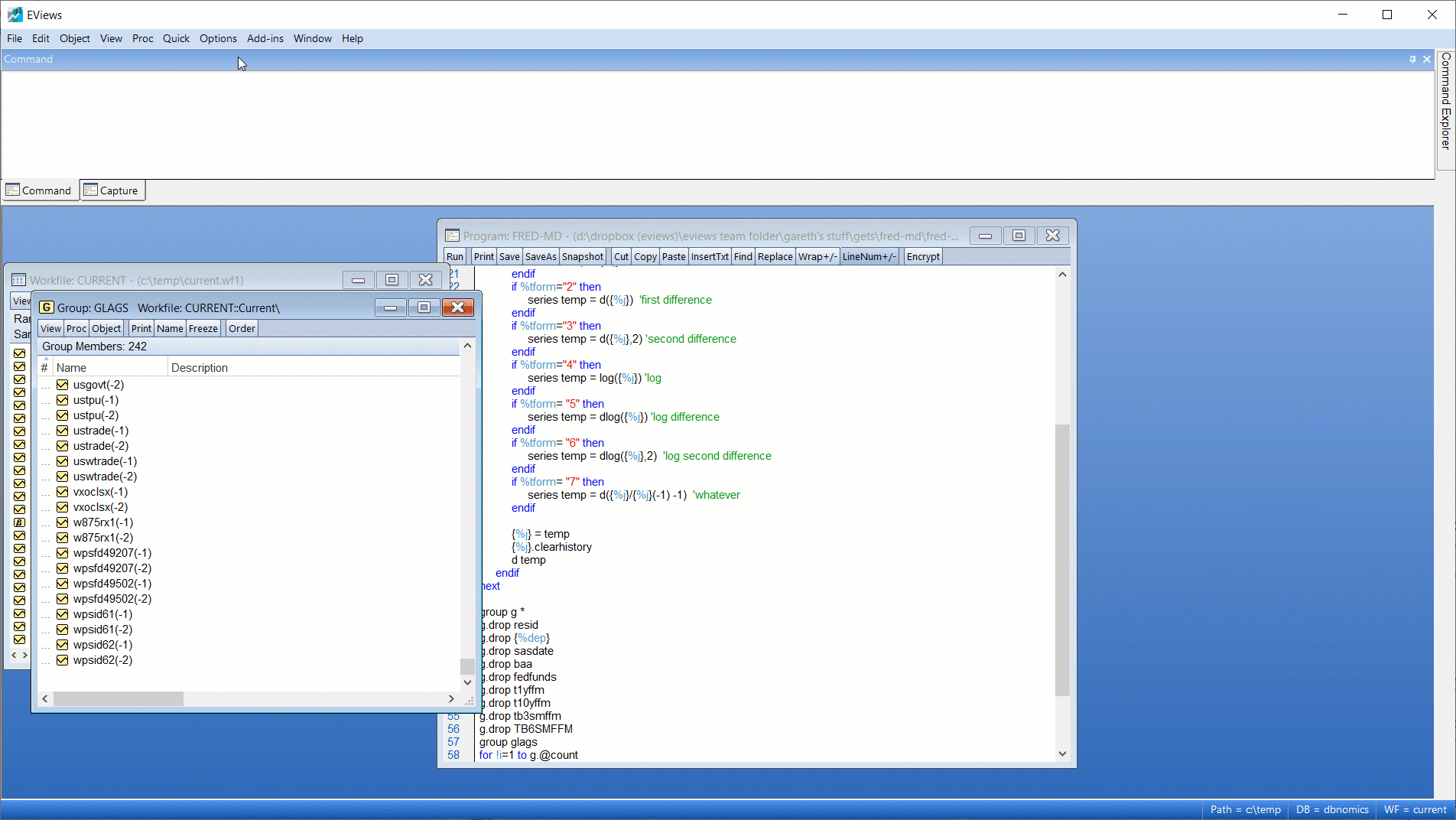EViews 12 New Econometrics and Statistics: Estimation
EViews 12 includes a number of new estimation techniques:
- Variable Selection Methods
- Indicator Saturation
- Fractionally Integrated GARCH Models
- Elastic Net, Ridge and LASSO Enhancements
- Panel Clustered Covariances
- Mixed Frequency (MIDAS) Enhancements
- Functional Coefficient Enhancements
Variable Selection
Variable selection, or feature selection as it is sometimes called in computer science literature, is an important component of modern machine learning. EViews includes five such techniques:
- Stepwise
- Swapwise
- Combinatorial
- LASSO
- Auto-Search/GETS
The first three of these were introduced fifteen years ago with EViews 6, but the modern, more popular, techniques of LASSO and Auto-search/GETS are new in EViews 12.
LASSO Selection
LASSO variable selection has become the go-to method of variable selection in modern econometrics. While LASSO estimation was available in previous versions of EViews, EViews 12 allows you to use the LASSO estimation technique purely as a variable selection method.

Auto-Search/GETS
The General-To-Specific auto-search/GETS algorithm follows the steps suggested by AutoSEARCH algorithm of Escribano and Sucarrat 2011, which in turn builds upon the work in Hoover and Perez 1999.

Indicator Saturation
EViews 12 adds regression tools for testing for the existence of outliers and structural breaks in a regression specification based on the indicator saturation approach.
The indicator saturation approach is an extension of least squares regression for testing for outliers and structural breaks in a regression specification. The indicator saturation approach works by including indicator variables for outliers or structural breaks at every observation in the regression, and then employing the GETS algorithms to select which of the included variables should be retained in a final regression model.
Fractionally Integrated GARCH Models
GARCH models have been a fundamental part of the EViews estimation tool kit for over thirty years, however the traditional GARCH models estimated by EViews have focused on the short term dynamics of conditional variance.
EViews 12 introduces two new GARCH model that capture long run dependence properties of variance.
- The FIGARCH model of Baillie, Bollerslev and Mikkelsen (1996)
- The FIEGARCH model of Bollerslev and Mikkelsen (1996)
Elastic Net, Ridge and LASSO Enhancements
Elastic Net (ENET) estimation, including the Ridge Regression and LASSO Estimation models, was added in EViews 11, and has proven a popular addition to the machine learning tools in EViews.
We have enhanced ENET in EViews 12 with the following features:
- Time series based cross-validation methods.
- New model selection views for displaying cross-validation results.
- Observation weights.
- Variable weights.
Panel Clustered Covariances
In a panel equation and pool settings, versions of EViews prior to EViews 12 offered tools for computing coefficient covariances accounting for clusters defined by cross-section units or by periods. Following the lead of the system estimation literature, these robust standard error calculations were termed “White cross-section” for clustering by period, to indicate that there was contemporaneous correlation between cross-section units, and termed “White period” for clustering by cross-section, to indicate that there was between period correlation within a cross-section unit.
EViews 12 extends these tools to allow for computation of robust covariances when clusters are defined by both cross-section units and periods (Petersen 2009, Thompson 2011, Cameron, Gelbach, and Miller 2015).
Mixed Frequency (MIDAS) Enhancements
The univariate MIDAS estimator in EViews 12 has been enhanced to use the Auto-Search/GETS algorithm to determine the which high-frequency variables to include in a U-MIDAS environment, as well as including Indicator Saturation methods.
A practical demonstration of MIDAS-GETS used in nowcasting is available on the EViews blog.
Functional Coefficient Enhancements
The popular functional coefficient estimator added in EViews 11 has been expanded to include forecasting and other miscellaneous improvements.
